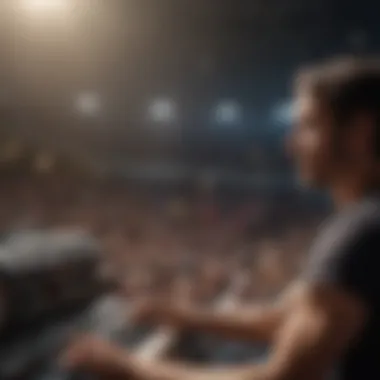Strategies to Amplify Your Musical Presence


Intro
The music industry is complex and constantly evolving. For musicians, standing out among the crowd requires more than just talent. It demands strategic thinking and a multifaceted approach to visibility. This article investigates various strategies that can help artists elevate their music careers. The goal is to offer practical solutions, promoting visibility and audience engagement, ensuring that musicians can effectively navigate this dynamic landscape.
By focusing on digital marketing, social media effectiveness, collaborations, and the use of data analytics, this guide aims to target artists at different stages in their careers. New and seasoned musicians will find applicable strategies to not only enhance their presence but also foster meaningful connections with audiences.
Understanding these strategies is crucial, as visibility directly impacts an artist's potential for success. The following sections delve deeper into the methods musicians can utilize to amplify their musical presence.
Music Promotion and Digital Marketing Strategies
In today's digital age, effective music promotion is essential. Musicians must embrace various platforms and tools to connect with audiences. Here are some strategies worth considering:
- Social Media Engagement: Utilizing platforms like Facebook, Instagram, and TikTok can vastly enhance an artist's reach. Regular updates and engaging posts can cultivate a loyal fanbase.
- Content Creation: Quality content is vital. Musicians should share behind-the-scenes footage, music videos, and personal stories to create a more intimate connection with their audience.
- Email Marketing: Building an email list provides a direct channel to fans. Regular newsletters can include information about new releases, upcoming concerts, and exclusive content.
- Targeted Advertising: Many platforms offer targeted advertising options. By investing in ads, musicians can reach specific demographics that align with their style and genre.
These promotion strategies not only increase visibility but help artists stay relevant in an ever-changing industry.
Collaborations and Networking
Collaboration is a powerful way for musicians to increase their visibility. By partnering with other artists, they can reach new audiences and create unique sounds. Here are key aspects of collaboration:
- Cross-Promotion: When two artists collaborate, they can share their fanbases, exposing each other's work to a wider audience.
- Diverse Influence: Working with different musicians allows for experimentation with sounds and styles that can reinvigorate an artist’s own music.
- Event Participation: Collaborating on live performances or music festivals can provide exposure and help build a professional network in the industry.
Networking may also play a significant part in building relationships with producers, writers, and other industry professionals. Engaging in events and using platforms like LinkedIn can help build these connections.
Data Analytics for Musicians
Data analytics has become a pivotal element in music promotion. By interpreting audience data, musicians can make informed decisions that align with their target demographic. Here are a few key points:
- Streaming Analytics: Platforms like Spotify and Apple Music provide data on listening habits. By understanding what songs are popular, artists can tailor future releases.
- Social Media Analytics: Each social media platform offers insights into follower engagement. This data helps artist understand what content resonates best.
- Target Audience Research: By analyzing demographic data, musicians can identify their core audience and focus promotional efforts effectively.
Understanding the Modern Music Landscape
The modern music landscape has transformed significantly in recent years. It reflects changes in technology, audience behavior, and industry practices. Understanding this landscape is crucial for musicians aiming to amplify their presence.
With digital platforms dominating music consumption, artists must adapt. These platforms provide vast opportunities for exposure, but they also mean increased competition. Musicians must realize that to succeed, they need to understand how to navigate this digital realm effectively.
Additionally, shifting listener preferences are not to be ignored. Different demographics have varied taste and they are often influenced by new trends, social media, and accessible platforms. Being mindful of what audiences engage with leads to better strategy and reach.
Knowing the modern music landscape is not simply about following trends. It requires a deep understanding of the tools available. Musicians need to leverage technology wisely to create meaningful connections with fans. As digital accessibility multiplies, the power of independent artists grows, and understanding these dynamics can lead to significant career advancements.
The Digital Transition in Music
The digital transition has revolutionized how music is produced, distributed, and consumed. Traditional methods are now supplemented by digital alternatives. Artists are no longer restricted by label control or geographical boundaries. Platforms such as Spotify, Apple Music, and Bandcamp allow musicians to share their work directly with fans.
Moreover, social media serves as a powerful promotional tool. Platforms like Facebook and Instagram enable artists to engage with audiences effectively. This environment fosters direct communication. It makes the relationship between artists and fans more personal. The result is often a more loyal following.
Artists should also be attentive to changes in consumer behavior. Digital platforms have made music consumption more immediate. Listeners often prefer single tracks or short playlists rather than entire albums. Understanding this behavior can inform release strategies and promotional efforts.
Shifting Listener Preferences
The preferences of music listeners evolve continuously. Genres rise and fall, but the underlying factors are often tied to cultural shifts and technological advancements. This evolution is essential for artists to understand. Knowing what drives audience engagement can influence everything from songwriting to marketing strategies.
Listeners today tend to seek authenticity. They are drawn to artists who seem genuine and relatable. Musicians should cultivate a unique identity that resonates with their audience. Personal narratives and honest storytelling can enhance listener connection.
In summary, to thrive in this shifting landscape, musicians have to be agile and informed. They should show resilience in the face of change and readiness to evolve. This adaptability is the key to expanding their reach and establishing a lasting presence in the modern music scene.
Developing Your Unique Sound
In today's saturated music industry, developing a unique sound is essential for any artist looking to stand out. Your sound not only defines your musical identity but also shapes how listeners perceive you. A well-crafted sound can resonate with fans and create a lasting impact. Therefore, it is crucial to invest time and effort to articulate what makes you different from others in the field.
Finding Your Musical Identity
Finding your musical identity involves self-discovery and exploration of various genres, styles, and influences. This journey can help you genuinely express your ideas and feelings through your music. Here are some steps to guide you:
- Listen to Diverse Genres: Immerse yourself in different types of music. Explore genres outside your comfort zone. This can spark inspiration and help you identify what you like or dislike.
- Evaluate Your Influences: Consider the artists who have shaped your musical taste. Analyze what elements of their work speak to you most. This evaluation can guide you in designing your cohesive sound.
- Experiment: Do not be afraid to experiment with different instruments, production techniques, and songwriting approaches. This trial can lead to unexpected discoveries that contribute to your sound.
- Stay True to Yourself: While it's important to draw inspiration from others, ensure that your music reflects your personality and experiences. Authenticity is key in creating a sound that is distinctly yours.


The Importance of Authenticity
Authenticity in music cannot be overstated. It allows artists to establish a genuine connection with their audience. Here are several reasons why authenticity matters:
- Builds Trust: Listeners appreciate when an artist is true to themselves. Authenticity fosters trust and loyalty among fans, encouraging them to support your work.
- Differentiates You from Others: In a music landscape often dominated by trends, authenticity helps you carve out a unique space. Your distinct perspective will attract a dedicated fanbase.
- Enhances Emotional Connection: Music is a form of emotional expression. Authenticity allows you to convey your feelings effectively, creating a deeper bond with your listeners.
- Long-term Success: While trends may fade, authenticity tends to stand the test of time. Artists who remain true to their unique sound often see lasting success and relevance.
"Authenticity is the key ingredient to a sustainable music career. It is not only about expressing yourself but doing so in a way that resonates with others."
Harnessing Social Media for Promotion
In the current musical landscape, social media is a powerful tool for artists. It allows musicians to connect with fans, share their work, and promote their brand effectively. Utilizing social media is crucial for enhancing visibility in an increasingly crowded space. Artists have the opportunity to engage directly with their audience, which fosters deeper connections. The right social media strategy can lead to more followers and better engagement.
Choosing the Right Platforms
Not all social media platforms are created equal. Each platform has unique characteristics that can benefit different artists based on their target audience and music genre. For example, Instagram is highly visual, making it ideal for showcasing artistic images or short clips of live performances. Facebook is more community-oriented and allows for detailed event promotion. Twitter is useful for real-time updates and interactions.
When deciding on platforms, consider:
- Your genre of music
- Your target demographic
- The type of content you want to create
By selecting the right platforms, you can maximize your reach and engagement. It is essential to monitor where your audience spends their time.
Crafting Engaging Content
Creating engaging content is the cornerstone of any successful social media strategy. Artists should consider various forms of content, such as videos, behind-the-scenes footage, or fan interactions. Content should resonate with your target audience and reflect your musical identity.
Important aspects include:
- Authenticity: Share unique insights about your music creation process.
- Consistency: Maintain a regular posting schedule to keep your audience engaged.
- Interactive Posts: Use polls or Q&A sessions to encourage audience participation.
The content should feel genuine. Audiences can often tell when someone is not being real.
Building a Community Around Your Music
Building a community can enhance your musical presence significantly. When fans feel like part of a community, they are more likely to engage with your work and promote it to others. This can be cultivated through:
- Responding: Reply to comments and messages to acknowledge your fans.
- Exclusive Events: Host live sessions or virtual meet-and-greets to foster connection.
- User-Generated Content: Encourage fans to share their own content related to your music. This generates organic promotion and strengthens community bonds.
"Building a loyal fan base requires time and genuine interaction. Every engagement is an opportunity."
By nurturing this community, you create advocates for your music. They can amplify your visibility through shares and word-of-mouth.
Collaborations and Networking
The landscape of the music industry is heavily influenced by connections and partnerships. Collaborations and networking play a pivotal role in amplifying your musical presence. Engaging in these activities can open up new opportunities, expand your audience, and enhance your artistic portfolio. Key benefits of forging relationships in the music sector include access to new resources, shared fan bases, and increased visibility. Building a supportive network is essential for any artist aiming for longevity and recognition in this highly competitive field.
Strategic Partnerships with Other Artists
Collaborations with fellow musicians can be mutually beneficial. When artists join forces, they not only blend their talents but also combine their audiences. This partnership provides a unique chance to reach listeners who may not have discovered your music otherwise.
The process of finding the right partners is crucial. Consider these factors when looking for collaborations:
- Complementary Styles: Choose artists whose style aligns with yours. A mismatched collaboration can confuse audiences.
- Shared Values and Goals: Ensure that both parties have a similar vision for the project. This harmony can contribute to a smoother creative process.
- Potential Impact: Analyze the other artist's reach and influence. A partnership with a more established artist can significantly boost your visibility.
Collaborations may take various forms. You could work on joint tracks, guest appearances, or even co-host events. Each opportunity strengthens your network and adds depth to your repertoire. Remember to approach collaborations with an open mind; sometimes, unexpected combinations yield the best results.
Engaging with Music Industry Professionals
Networking extends beyond fellow musicians. Engaging with industry professionals is equally important. This often includes producers, managers, booking agents, and other key players who can help advance your career. Consider the following strategies:
- Attend Industry Events: Conferences, workshops, and festivals are great venues for meeting professionals.
- Leverage Social Media: Platforms like Facebook can be used to connect with industry experts. Follow them, comment on their posts, and start a dialogue.
- Build Relationships with Relevance: When approaching someone, contextualize your outreach. Explain how your music may align with their interests or benefits their work.
A strategy focused on engagement rather than mere promotion will yield better results. Networking is a two-way street. Offer value to your connections where possible. Whether it's your music, insights, or assistance on a project, building goodwill is crucial.
"Your network is your net worth."
In summary, collaborations and networking are vital components in establishing a strong presence in the music industry. Through strategic partnerships and meaningful relationships with industry professionals, you can expand your reach and elevate your artistic journey.


Live Performances and Gigs
Live performances and gigs represent a pivotal avenue for musicians aiming to amplify their presence in the music industry. This aspect of a musician's career is not just about showing up on stage; it is a powerful platform for connecting with audiences, showcasing talent, and establishing a brand. Performances can significantly impact an artist’s reach and reputation, providing both immediate engagement and long-term benefits.
The Value of Local Shows
Local shows serve as a foundational element for many artists. They allow musicians to gain experience, develop a loyal fan base, and hone their live performance skills. Performing in familiar venues creates a sense of community and connection, making it easier to draw in local supporters.
Engaging with an audience at local shows fosters personal rapport. Fans often appreciate the intimate atmosphere and the ability to interact with the artist. Here are several key benefits of local performances:
- Building a Local Fan Base: Consistent performances create a following, as regular attendees will likely return for more shows.
- Networking Opportunities: Local events are fertile ground for meeting other musicians, industry professionals, and potential collaborators.
- Feedback Loop: Gigs provide immediate feedback on new material, helping artists to refine their sounds and performances based on audience reactions.
- Cost-Effective Promotion: Local gigs often require less overhead, allowing for affordable promotion without the substantial financial risks associated with larger events.
- Experimentation Space: Local shows offer a chance to try new songs or concepts, allowing artists to gauge audience reactions in a low-pressure environment.
Leveraging Festivals and Larger Venues
Festivals and larger venues represent a different level of exposure for artists. These events typically attract a diverse audience, often including potential fans who might not be familiar with the artist's work. For musicians looking to broaden their reach, leveraging these opportunities is crucial. Here are several ways to make the most of these larger platforms:
- Increased Visibility: Playing at a festival often places the artist alongside well-known acts, facilitating visibility that can significantly expand their audience.
- Media Exposure: Festivals often attract media representatives, which can lead to interviews, features, or reviews that boost an artist's profile.
- Merchandising Opportunities: Larger venues provide the chance to sell merchandise to a wider audience, maximizing potential revenue streams.
- Strategic Timing: Performing at peak times within a festival can lead to larger crowds, so artists should strive to understand the schedule to maximize their impact.
- Leveraging Social Media: Festivals often have strong social media presence. Artists can engage with the festival’s audience, promoting their brand more effectively.
Live performances and gigs are not just opportunities to share music; they are vital engagements that shape an artist's career. They provide platforms to connect, network, and grow within the competitive landscape of the music industry.
Overall, both local shows and larger festivals are integral components of a musician's strategy for amplifying their presence. By carefully selecting gigs, engaging with audiences, and utilizing each opportunity for interaction and feedback, musicians can build a robust platform for their artistic endeavors. These performances resonate in the minds of fans, often solidifying lasting connections that extend beyond the stage.
Understanding Music Distribution
Music distribution plays a pivotal role in the success of any musician. It is the mechanism through which artists deliver their music to audiences, whether through physical copies like CDs or digital formats via streaming platforms. In today's digital age, understanding music distribution is essential for musicians who want to amplify their presence and reach potential fans around the world.
The relevance of music distribution lies in its ability to broaden an artist's audience. It allows musicians to make their work accessible, creating opportunities for discovery and engagement. Furthermore, effective distribution strategies can ultimately impact profitability by allowing for a diversified income stream.
As the industry evolves, musicians must consider various elements of distribution to maximize their potential. This includes evaluating what platforms will best showcase their music, understanding licensing agreements, and keeping informed on the latest trends in digital distribution. By having a firm grasp of these aspects, musicians can better navigate their careers in an increasingly competitive landscape.
Choosing the Right Distribution Channels
Choosing the right distribution channels is crucial for effective music distribution. Musicians must evaluate their target audience and identify where their listeners are most active. Popular digital platforms such as Spotify, Apple Music, and Amazon Music provide extensive reach, while niche services might be more appropriate for certain genres or demographics.
Each platform has distinct advantages:
- Spotify: Renowned for its user-friendly interface and extensive playlists, it can help artists gain substantial visibility.
- Apple Music: Appeals to users who are loyal to the Apple ecosystem; offers curated playlists that can lead to more exposure.
- Bandcamp: Supports independent artists significantly, allowing better profit margins directly from sales.
When selecting distribution channels, artists should analyze the demographics and listening habits of their audience. Understanding where fans prefer to listen can inform the best choices for distribution. Additionally, it may be beneficial to leverage multiple platforms simultaneously to maximize reach.
Maximizing Streaming Revenue
Maximizing streaming revenue is increasingly essential for musicians in the digital era. royalty rates can vary significantly from one service to another, and being cognizant of these differences is vital. Streaming platforms often follow a pro-rata payment model, meaning artists earn based on their share of total streams. Therefore, gaining a larger listener base directly increases potential earnings.
To optimize revenue, artists should consider the following strategies:
- Promote on Social Media: Share links to your music across various social platforms to drive traffic.
- Engage with Fans: Create content that encourages listeners to share your music, increasing streams organically.
- Don’t Neglect Analytics: Platforms like Spotify for Artists provide insights that can help tailor strategies to better engage your audience.
Lastly, collaboration with other artists can broaden exposure. When musicians work together, they often share their fan bases, leading to increased streams and revenue.
"Understanding distribution channels and maximizing streaming revenue are keys to an artist's visibility in the music industry."
By prioritizing these elements, musicians will enhance their ability to thrive in the modern music landscape, ultimately translating their artistic efforts into tangible financial success.
Utilizing Data Analytics
In today’s music industry, data analytics is not just a tool; it’s a necessity for artists wishing to amplify their presence. Understanding the impact and scope of data analytics can significantly influence promotion strategies, audience targeting, and overall success.
Effective use of data analytics helps musicians decode listener habits and preferences. By examining listener behavior, artists can identify what resonates with their audience. Knowing which songs are most streamed, the demographics of their listeners, and how fans interact with their music enables artists to tailor their content and marketing approaches effectively. Thus, data analytics is imperative in gaining insights that drive growth.
Understanding Your Audience
Grasping who your audience is, and what they like, is crucial for artists. Analytics tools can provide a detailed breakdown of audience demographics, including age, location, and gender. For instance, utilizing services like Spotify for Artists provides detailed stats on streams, listener locations, and even playlists where songs are featured. These insights allow musicians to refine their marketing and outreach efforts, ensuring they reach the right people.
Moreover, knowing the audience's musical tastes can lead to better targeting decisions. For example, an artist may find that their music has a higher listener base in urban areas. With this knowledge, they can focus on urban-centric marketing campaigns or performances, ultimately yielding a higher return on effort and investment.
Tracking Your Growth and Engagement


Tracking growth metrics is vital in understanding an artist’s journey. Analytics tools allow musicians to monitor key performance indicators such as listener growth, engagement rates on social media, and streaming statistics. This data helps to set realistic goals and measure progress consistently over time.
Engagement is another crucial component. By analyzing metrics like social media likes, shares, comments, and overall interaction rates, artists can gauge how well their content is received. If an artist notices higher engagement from certain types of posts or content formats, they can replicate this success moving forward.
To summarize, the ability to utilize data analytics can significantly enhance a musician’s ability to amplify their presence. It provides insights into audience preferences and tracks essential growth metrics, guiding artists towards more informed, effective strategies in their marketing and outreach endeavors.
"Without data, you’re just another person with an opinion." – W. Edwards Deming
Marketing Strategies for Musicians
Marketing is a crucial component for any musician aiming to elevate their presence in the competitive music industry. A well-defined marketing strategy helps artists connect with listeners, build a brand, and ultimately grow their audience. This section explores key methods and considerations essential for effective marketing.
Creating a Comprehensive Marketing Plan
A marketing plan serves as a roadmap for musicians. It outlines specific goals and the steps to achieve them. The importance of having a comprehensive plan cannot be overstated.
- Identifying Your Target Audience:
Understanding who your fans are is the first step. Are they teenagers, young professionals, or older music lovers? Knowing this helps tailor your approach. - Setting Clear Objectives:
Consider what you want to achieve. Is it gaining more followers on social media, selling out a concert, or increasing streaming numbers? Defining specific, measurable goals will guide your efforts effectively. - Crafting a Unique Brand Identity:
Every artist needs a brand that resonates. Define your visual and sonic elements that differentiate you from others. This identity should reflect in all your marketing materials, from logos to social media posts. - Choosing Your Marketing Channels:
Social media, email lists, and music platforms are integral. Decide where your audience spends most of their time and focus your marketing accordingly. - Creating a Content Calendar:
Planning content in advance keeps you organized and ensures a steady flow of engaging materials. Include promotional posts, behind-the-scenes glimpses, or announcements for upcoming events.
By following these guidelines, musicians can create a structured marketing approach. This enhances chances of growth and visibility in the industry.
The Role of Public Relations
Public relations (PR) is a vital aspect of marketing that often gets overlooked. It involves managing the spread of information between the artist and the public. Effective PR can lead to increased awareness, credibility, and engagement.
- Building Relationships with Media:
Connect with journalists, bloggers, and influencers who cover music. A solid relationship can lead to features, interviews, and reviews which amplify your exposure. - Press Releases:
A well-crafted press release can announce new music, tours, or collaborations. It should be concise, informative, and tailored to the audience in question. - Managing Online Reputation:
Artists are often scrutinized on various platforms. How you respond to criticism or compliments can shape public perception. Always maintain professionalism and openness. - Utilizing Fan Engagement:
Engage with your fans through social media and like platforms such as Facebook. Share your journey, and invite them to participate in discussions. This creates a loyal fanbase.
Incorporating PR into a broader marketing strategy is beneficial. It enhances visibility and strengthens connection with the audience. Incorporating thoughtful marketing and PR strategies together sets the stage for success in the music landscape.
"In the music industry, visibility is everything. A well-positioned marketing strategy is key to ensuring your work is heard and celebrated."
Leveraging these marketing strategies effectively can lead to sustained growth and recognition within the music industry.
Embracing Industry Trends
Staying ahead in the music industry requires an understanding of evolving trends. Musicians must accept that the landscape is continually shifting. Embracing these trends allows artists to remain relevant, maximize engagement, and increase their reach. Factors like changing listener habits, new technologies, and social media shifts can all influence a musician's strategy to amplify their presence. By being aware of these trends, artists can make informed decisions that align with their goals.
Keeping Abreast of Changes in the Music Scene
The music scene evolves rapidly. This makes it essential for artists to keep informed about developments that affect their work. Following industry news and trends is crucial for several reasons. First, it enables musicians to understand what is popular and what resonates with audiences. For example, the popularity of genres such as lo-fi hip hop or indie pop can change over time. Knowing this helps artists tailor their music or marketing strategies accordingly.
More importantly, being aware of changes can assist in anticipating future shifts. The rise of podcasting, live streaming, and influencer partnerships in recent years showcases how diverse entertainment options are. Musicians can leverage these trends to highlight their work in innovative ways. Engaging with platforms like TikTok or Instagram Reels offers new avenues for exposure.
Furthermore, participating in conversations through platforms like Reddit or Facebook can provide insights into what listeners are seeking. Engaging with fan communities and seeking feedback demonstrates a willingness to adapt. This adaptability is key in a competitive market.
Adapting to New Technologies
Technology significantly influences how music is created, distributed, and consumed. Artists must be open to new tools and platforms to remain competitive. The rise in popularity of artificial intelligence in music production is an example. Musicians can leverage AI tools for composition or mixing, leading to new sounds and experimentation.
Additionally, advancements in streaming technology shape how listeners access content. With platforms like Spotify or Apple Music, artists can reach wide audiences. Understanding algorithms and utilizing them effectively can boost an artist’s visibility. Regularly analyzing data is crucial for refining strategies.
Moreover, adapting to changes in technology involves being proactive. Investing time in learning about different distribution channels and marketing tools can pay off. This knowledge will help maximize opportunities for exposure.
"Embracing new technologies allows artists to innovate and connect with their audience in ways previously not possible."
Fostering Fan Engagement
Fostering fan engagement is crucial for any musician aiming to create a lasting footprint in today’s competitive music landscape. Engagement does not only imply superficial interactions; it goes deeper than surface-level connections. This process creates a community where fans feel valued and involved. The benefits of engaging with fans are manifold, ranging from enhanced loyalty to increased word of mouth promotion.
A primary consideration when fostering fan engagement is understanding what resonates with your audience. Fans are more likely to engage if they feel a personal connection. This can be achieved by sharing personal stories, insights into the creative process, or even day-to-day experiences. Fans tend to appreciate transparency and authenticity, which builds trust between the artist and the audience.
Creating Exclusive Content for Fans
Creating exclusive content for fans is an effective way to enhance engagement. This content could range from behind-the-scenes videos and early access to new music, to exclusive merchandise or fans-only events. The purpose of exclusive content is to make your fans feel special and appreciated. When fans perceive they have access to something unique, their loyalty typically increases.
Consider using platforms like Patreon or Bandcamp to share this exclusive content. Also, you can utilize social media platforms such as Instagram and Facebook to offer live Q&A sessions or virtual meet-and-greets. This not only boosts interaction but also makes fans feel like a part of your musical journey.
Utilizing Fan Feedback for Growth
Utilizing fan feedback is a key strategy for continuous growth. Musicians can gather input on everything from song preferences to concert experiences. This feedback serves two primary purposes. First, it allows you to understand what your audience enjoys or dislikes, ultimately allowing you to refine your work. Second, this inclusion fosters a sense of belonging among fans.
To effectively solicit feedback, create polls on social media, or ask open-ended questions during concerts. Actively responding to this feedback also lays the groundwork for a stronger artist-fan relationship. As your audience sees that their opinions matter, they are likely to remain engaged and supportive as you evolve.
"Engaging with fans transforms them from mere listeners into invested community members."







